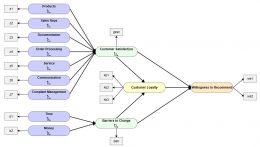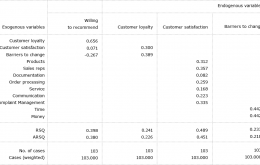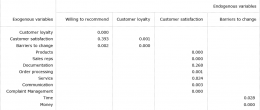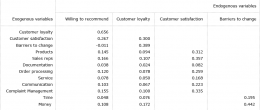Practical example: Structural equation model
Objective
To strengthen his position in an ever more challenging environment (globalization, fierce competition, new sales channels, critical customers), a medium-sized manufacturer of printing machines conducted a survey of his customers with the aim of discovering the decisive drivers of customer loyalty. Furthermore, in order to win new customers, the mechanisms for achieving a high willingness by existing customers to recommend the company were to be analyzed.
On the basis of existing theories, a model was adapted to cover the above-mentioned causal relationships.
Customer loyalty is determined by customer satisfaction and the extent of barriers to change. For satisfaction there is a range of influences relating to customers’ concrete experiences with the company. Barriers to change are determined by the loss of time and money associated with the planning and implementation of a change of suppliers. A central issue was whether loyalty was strengthened more by satisfaction, or more by the barriers to change.
Drivers of willingness to recommend were taken to be the influences of satisfaction and loyalty, plus effects related to the barriers to change.
Analysis
The above-mentioned latent variables (represented by ellipses in the model chart) had to be measured by means of suitable indicators (rectangles in the model chart):
The drivers of satisfaction were each measured by an item (z1 to z7) on a scale from 1 = “very satisfied” to 5 = “very dissatisfied”. The same was done for overall satisfaction (gesz).
The drivers of barriers to change were each measured by an item (b1 and b2) on a scale from 1 = “high” to 5 = “low”, and barriers to change were also included as a separate item (barr) on the same scale.
To measure customer loyalty, three items were used which covered both attitudes (kb1 and kb2) and behavior (kb3). The following statements were queried on a scale from 1 = “applies completely” to 5 = “does not apply at all”:
- “I feel very commited to Company XX.” (kb1)
- “I would regret it very much if Company XX no longer existed as a supplier of printing machines.” (kb2)
- “I will continue to place orders for printing machines with Company XX in future.” (kb3)
For willingness to recommend, the following items were used:
- “If a business partner asked me, I would recommend Company XX.” (we1)
- “I would advise everybody to always request an offer from Company XX.” (we2)
These were also queried on a scale from 1 = “applies completely” to 5 = “does not apply at all”.
The calculation of the causal model was carried out using the tool RALV specifying the mutual independence of the drivers of customer satisfaction ( ), the independence of the two drivers of barriers to change ( ) and the independence of customer satisfaction and barriers to change ( ), , in order to avoid possible distortions in the results due to multicolinearity.
The following beta-coefficients and significance levels were generated for the sub-models and for total effects with regard to customer loyalty and willingness to recommend:
Both customer satisfaction and barriers to change reinforce customer loyalty. The influence of the barriers to change (0.389) on customer loyalty is greater than the influence of satisfaction (0.300). However, the positive indirect influence of the barriers to change on willingness to recommend (0.389 x 0.656 = 0.255) via customer loyalty is negated by its direct negative influence on willingness to recommend (-0.267), so that a slight negative total effect of -0.011 results. Thus, in this example, recommendations were neither influenced by barriers to change nor directly by customer satisfaction, but indirectly through the loyalty induced by customer satisfaction.
Thus, if the company wished to win new customers mainly through recommendations, it should take steps to ensure customer satisfaction. Here it is particularly noticeable that – alongside their satisfaction with the machines supplied – the customers are mainly satisfied with the support provided by the sales reps and with the handling of complaints. If the company wished to focus its efforts on retaining its existing customers, it should concentrate on raising the barriers to change (e.g. by conveying product-specific know-how).





